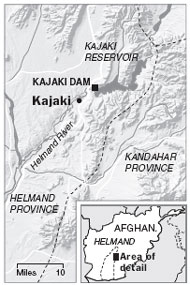 About a month ago, a 4,000 large contingent of American, Canadian, British, Danish, Australian, and Afghan soldiers made a heroic (yes, I’m watching and Saving Private Ryan right now, and these troops are just as valiant) effort in delivering a huge turbine to south Afghanistan's Kajaki Dam. Here is an update on those efforts which would more than double the electrical output in the Helmand Province along with many others which are in the heart of NATO/Afghan government's battle for supremacy against the Taliban.
About a month ago, a 4,000 large contingent of American, Canadian, British, Danish, Australian, and Afghan soldiers made a heroic (yes, I’m watching and Saving Private Ryan right now, and these troops are just as valiant) effort in delivering a huge turbine to south Afghanistan's Kajaki Dam. Here is an update on those efforts which would more than double the electrical output in the Helmand Province along with many others which are in the heart of NATO/Afghan government's battle for supremacy against the Taliban.
The large turbine has yet to be installed, but its safe arrival has brightened the prospects for the everyday lives of thousands of Afghani's, many of which live with only a couple hours of electricity a day. Though the $180 million dollar US-funded Kajaki Dam project is a great sign of hope, the events surrounding its arrival and installation portray the trying situation of the country. The Taliban are in control of much of the south and they have tried to derail the Kajaki's production and further improvement ever since 2001. The workers, both foreign and local, need protection from Taliban elements, who do not want to see the Afghan government gain control or legitimacy in the area, as a successful energy project such as the giant new turbine would provide.
In fact this project, along with the work and targeting of aid workers, could not paint a more clear picture of one aspect of this conflict that can be well-defined. Magnus Linklater said it best:
“Whose values best represent the interests of ordinary Afghans – those of the Western aid agencies working to shore up the country's infrastructure by building dams and opening up roads, or the violent extremists who shot Gayle Williams? {aid worker}”
The words of Helmand Province's governor also tell the story:
"The children of Afghanistan will not forget the work done for this power station."
As was mentioned, this project is far from complete and its future is far from assured, in fact if the turbine is successfully installed and starts to give southern Afghan's a greater supply of energy and jobs, it will be in many ways miraculous. These soldiers and workers, both foreign and local, may not be landing on a Nazi-controlled Normandy beach, but their efforts are giving a small swath of the world's citizens a chance at a better life.
(Map Source: New York Times)